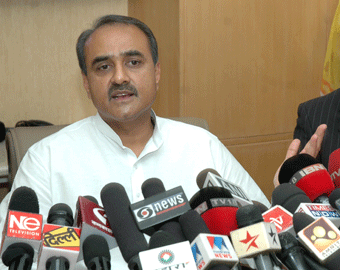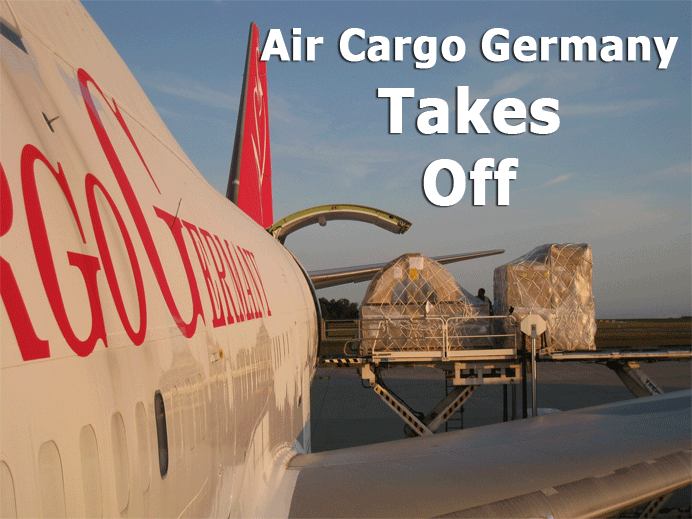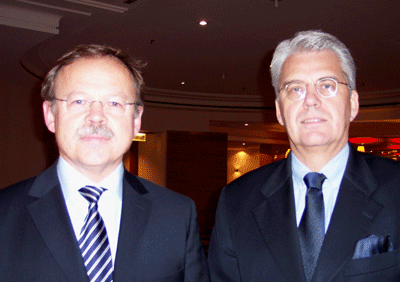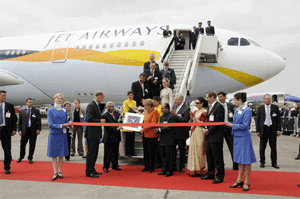India Cargo Fortunes
Rising

 (New
Delhi Exclusive)—Signs of hope are emerging on
the air cargo front. According to a statement in Parliament, India’s
Civil Aviation Minister Praful Patel said that the country’s
major airports could see a rise in freight tonnage between 2009 and
2012. Topping the list was Mumbai (pictured above). The minister’s
calculations for the financial capital of India: one percent in 2009-10,
6.99 percent growth in 2010-11, and eight percent in the 2011-12.
For Delhi, the growth figures projected were: 3.7 percent in 2009-10,
four percent in 2010-11 and five percent in 2011-12.
(New
Delhi Exclusive)—Signs of hope are emerging on
the air cargo front. According to a statement in Parliament, India’s
Civil Aviation Minister Praful Patel said that the country’s
major airports could see a rise in freight tonnage between 2009 and
2012. Topping the list was Mumbai (pictured above). The minister’s
calculations for the financial capital of India: one percent in 2009-10,
6.99 percent growth in 2010-11, and eight percent in the 2011-12.
For Delhi, the growth figures projected were: 3.7 percent in 2009-10,
four percent in 2010-11 and five percent in 2011-12.
The other major airports that are likely
to record impressive figures were: Chennai (2 percent in ’09-’10,
5 percent in ’10-’11 and 10 percent in ’11-’12),
Kolkata (3 percent in ’09-’10, 6 percent in ’10-’11
and 8 percent in ’11-’12), Bangalore (3.8 percent in ’09-’10,
6 percent in ’10-’11 and 7 percent in ’11-’12),
and Hyderabad (6 percent in ’09-’10, 8 percent in ’10-’11
and 9 percent in ’11-’12).
The minister also added the fact that
air cargo traffic from Indian metro cities had risen in 2007-08 but
had dropped slightly in 2008-09. His statement mentioned that the
total cargo tonnage handled at the metro airports at Mumbai, Delhi,
Chennai, Kolkata, Bangalore and Hyderabad was approximately 1,329,000
MT (in 2006-07), 1,457,000 MT (in 2007-08) and 1,418,000 MT (in 2008-09).
The optimistic forecast from the government
– despite the gloom created by the financial misfortunes of
Air India – has come following initiatives taken to boost air
cargo. Over the last couple of years, the government and the privately
held airports of Hyderabad and Kochi have spent more than Rs 830 crore
to enhance infrastructure at major airports.
Among these measures are investments
in air cargo handling infrastructure at airports, plans to set up
dedicated cargo cities with multi-modal interchanges, state-of-the-art
cargo terminals, cold storage facilities and electronic data interchange
systems. The government is also going ahead with the development of
a major international multi-modal cargo hub in Nagpur.
The other inputs include the implementation
of a 'Perishable Cargo policy' that offers various concessions for
setting up of state-of-the-art centers for perishable cargo. Also,
color X-ray machines have been installed at metro and non-metro airports
by the Airports Authority of India (AAI) conforming to the Bureau
of Civil Aviation Security guidelines that prescribe 100 percent screening
of export cargo, prior to loading on aircraft
In addition, AAI has introduced automation
in air cargo handling by introducing Elevated Transfer Vehicle (ETV)
for storage of ULDs of Export Cargo. Electronic Data Interchange (EDI)
through Internet with its community partners viz. Customs, airlines,
exporters, importers and others for exchange of messages electronically
also has been started.
Praful Patel is not the only one who
has an optimistic outlook. Though the preliminary figures released
recently by the Association of Asia Pacific Airlines (AAPA) showed
that international freight traffic saw a year-on-year decline for
the month of May ’09, Andrew Herdman, AAPA Director General
was a tad hopeful. He was quoted as saying that “the air cargo
business remains severely depressed following the slump in international
trade, but does appear to have stabilized. AAPA international air
cargo traffic in May was down 18.6 percent, a slight improvement on
the average decline of 23.2 percent seen during the first five months
compared to the same period last year.”
Considering the fact that Asia –
particularly India and China – will spearhead the revival of
the global slump, Praful Patel’s belief in the cargo sector
performing well is more than welcome.
Tirthankar Ghosh




 ACG
Air Cargo Germany's CEO Michael Bock, and Thomas Homering, Managing
Director
ACG
Air Cargo Germany's CEO Michael Bock, and Thomas Homering, Managing
Director  In
a couple of weeks a second leased B747-400SF will be utilized by ACG
Air Cargo Germany, Homering announces. The aircraft (code: D-ACGB)
arrived at Hahn Airport July 24, coming from KLM’s paint shop
in Amsterdam. There the freighter received its new red and white ACG
livery. Presently the jumbo craft is undergoing its regular C-Check
at Hahn-based MRO provider Haitec Aviation Technology.
In
a couple of weeks a second leased B747-400SF will be utilized by ACG
Air Cargo Germany, Homering announces. The aircraft (code: D-ACGB)
arrived at Hahn Airport July 24, coming from KLM’s paint shop
in Amsterdam. There the freighter received its new red and white ACG
livery. Presently the jumbo craft is undergoing its regular C-Check
at Hahn-based MRO provider Haitec Aviation Technology. 
 (New
Delhi Exclusive)—Signs of hope are emerging on
the air cargo front. According to a statement in Parliament, India’s
Civil Aviation Minister Praful Patel said that the country’s
major airports could see a rise in freight tonnage between 2009 and
2012. Topping the list was Mumbai (pictured above). The minister’s
calculations for the financial capital of India: one percent in 2009-10,
6.99 percent growth in 2010-11, and eight percent in the 2011-12.
For Delhi, the growth figures projected were: 3.7 percent in 2009-10,
four percent in 2010-11 and five percent in 2011-12.
(New
Delhi Exclusive)—Signs of hope are emerging on
the air cargo front. According to a statement in Parliament, India’s
Civil Aviation Minister Praful Patel said that the country’s
major airports could see a rise in freight tonnage between 2009 and
2012. Topping the list was Mumbai (pictured above). The minister’s
calculations for the financial capital of India: one percent in 2009-10,
6.99 percent growth in 2010-11, and eight percent in the 2011-12.
For Delhi, the growth figures projected were: 3.7 percent in 2009-10,
four percent in 2010-11 and five percent in 2011-12. Air
Cargo News FlyingTypers leads the way again as the world’s first
air cargo publication to connect the industry to the broadly expanding
and interactive base for social commentary—Twitter.
Air
Cargo News FlyingTypers leads the way again as the world’s first
air cargo publication to connect the industry to the broadly expanding
and interactive base for social commentary—Twitter.
 July
28: In China DHL opened a 24/7 domestic
transport hub in the Wuhan City Economy and Technology Development Zone
joining FedEx & TNT there.
July
28: In China DHL opened a 24/7 domestic
transport hub in the Wuhan City Economy and Technology Development Zone
joining FedEx & TNT there. July
28: Swissport now reports perfomance
to IATA’s Cargo 2000. “Some 56 stations are included covering
airlines we handle," John Batten, EVP said.
July
28: Swissport now reports perfomance
to IATA’s Cargo 2000. “Some 56 stations are included covering
airlines we handle," John Batten, EVP said.  Contact!
Talk To Geoffrey
Contact!
Talk To Geoffrey